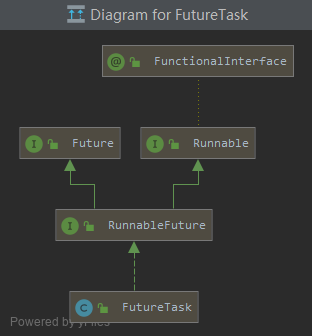1. 当我们执行Future future = executorService.submit(myCallable);代码时,我们执行了什么?

从类图可以看到,FutureTask实现了两个基类(Future,Runnable);这里实现Future的目的,很明确,因为Future就是代表一个异步任务的未来结果;
而Runnable,这里是因为JUC线程池通用执行run方法来执行任务的,之所以这么说,有个结论需要记住,线程池执行Callable的时候,其实是通过FutureTask的run方法去执行的;
//AbstractExecutorService.class
public <T> Future<T> submit(Callable<T> task) {
if (task == null) throw new NullPointerException();
RunnableFuture<T> ftask = newTaskFor(task);
execute(ftask);
return ftask;
}
//AbstractExecutorService.class
protected <T> RunnableFuture<T> newTaskFor(Callable<T> callable) {
return new FutureTask<T>(callable);
}
//FutureTask.class
public FutureTask(Callable<V> callable) {
if (callable == null)
throw new NullPointerException();
this.callable = callable;
this.state = NEW; // ensure visibility of callable
}
FutureTask的run代码如下:
public void run() {
if (state != NEW ||
!UNSAFE.compareAndSwapObject(this, runnerOffset,
null, Thread.currentThread()))
return;
try {
Callable<V> c = callable;
if (c != null && state == NEW) {
V result;
boolean ran;
try {
//这里去执行Callable的业务逻辑
result = c.call();
ran = true;
} catch (Throwable ex) {
result = null;
ran = false;
setException(ex);
}
//执行成功后直接将设置结果
if (ran)
set(result);
}
} finally {
// runner must be non-null until state is settled to
// prevent concurrent calls to run()
runner = null;
// state must be re-read after nulling runner to prevent
// leaked interrupts
int s = state;
if (s >= INTERRUPTING)
handlePossibleCancellationInterrupt(s);
}
}
2. 当我们使用FutureTask时,我们想要什么?
我们首先看看Future的API;
/**
* 尝试取消Callable的任务,因为Future是由Callable的索引的,所以功能上是没有问题的
* mayInterruptIfRunning参数,如果是false,那么如果Callable业务在队列里还没有被执行到,那么任务会被取消
* 那如果是true呢,那么如果Callable已经在执行中了,那么会将执行线程的中断标识置为true,当然如果业务逻辑不关心isInterrupt,起始对代码执行没有任何影响
*/
boolean cancel(boolean mayInterruptIfRunning);
/**
* 是否任务被取消
*/
boolean isCancelled();
/**
* 是否任务已经完成
*/
boolean isDone();
/**
* 首先这是一个阻塞方法,如果任务还没有被执行完
* 当任务执行完之后,会返回执行结果
*/
V get() throws InterruptedException, ExecutionException;
/**
* 有超时时间的get方法
*/
V get(long timeout, TimeUnit unit)
throws InterruptedException, ExecutionException, TimeoutException;
显然我们的目标是get()/get(long timeout, TimeUnit unit),当我们需要一个异步执行任务的结果时就可以通过get方法获取;但是缺点是阻塞当前线程,占用资源!